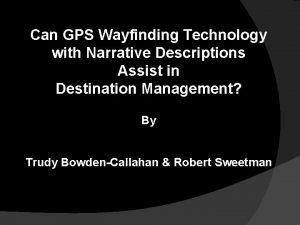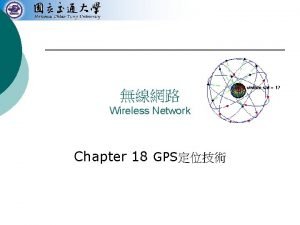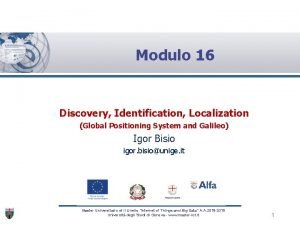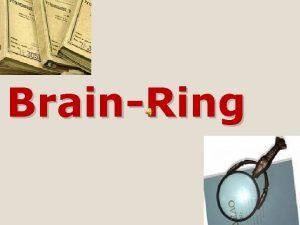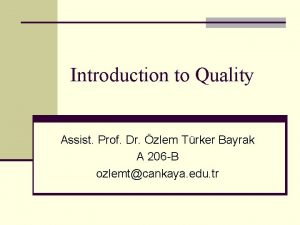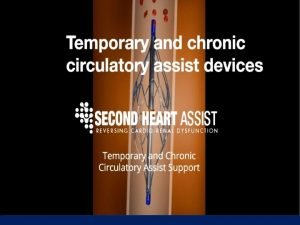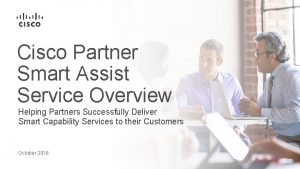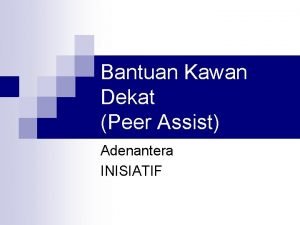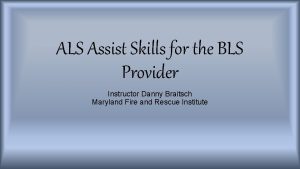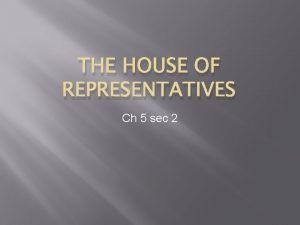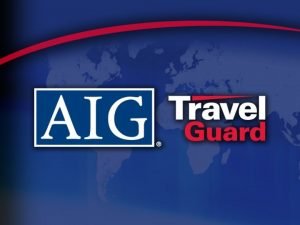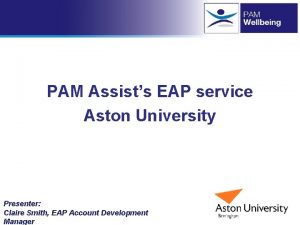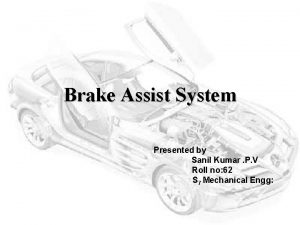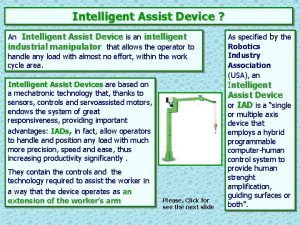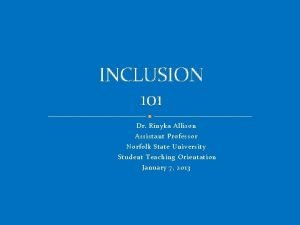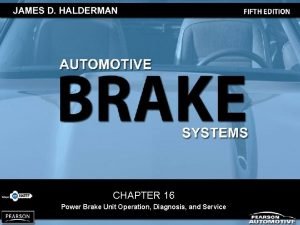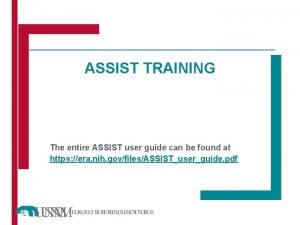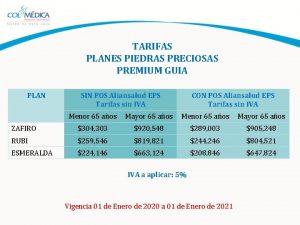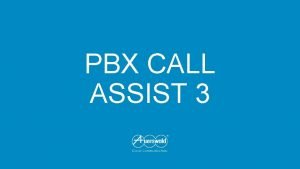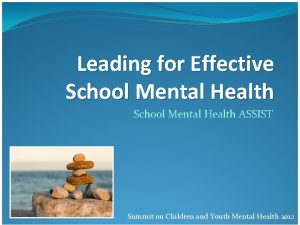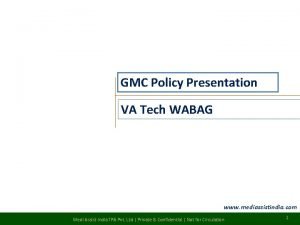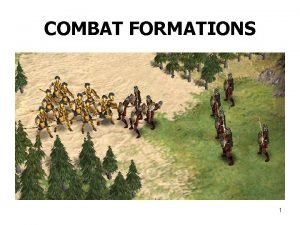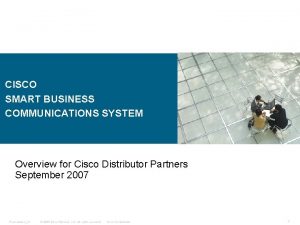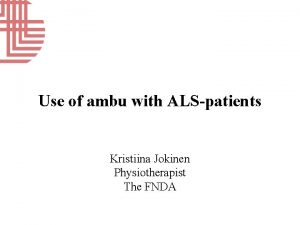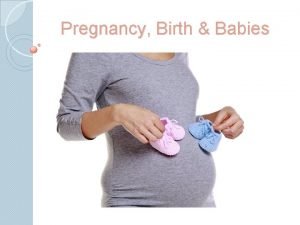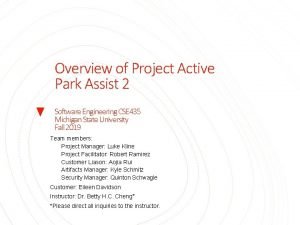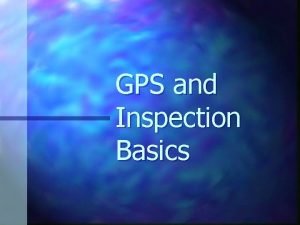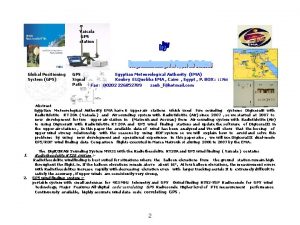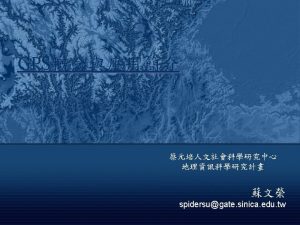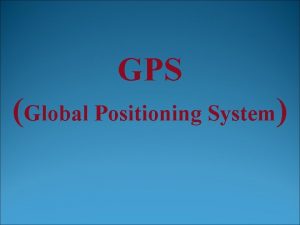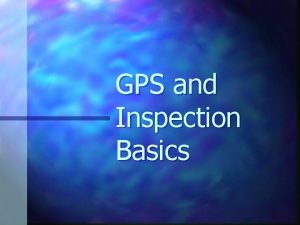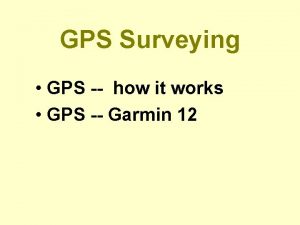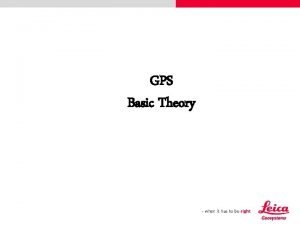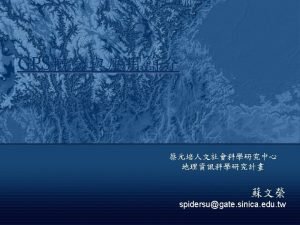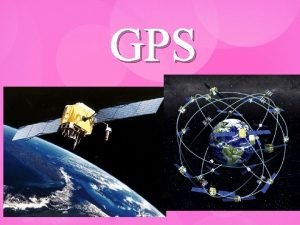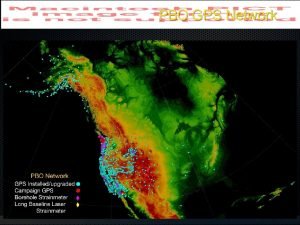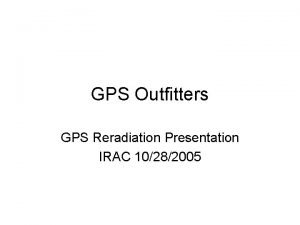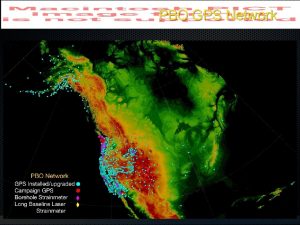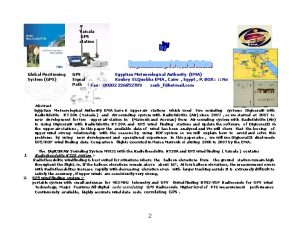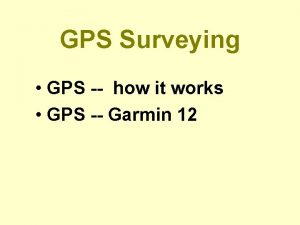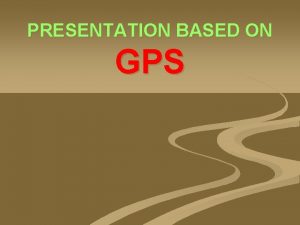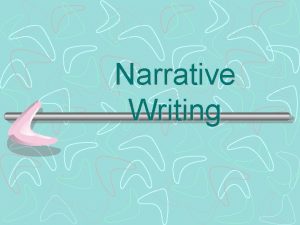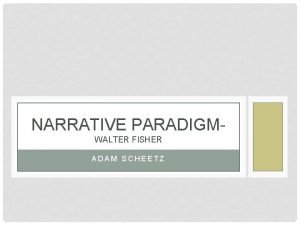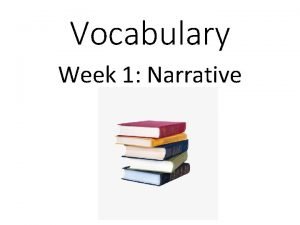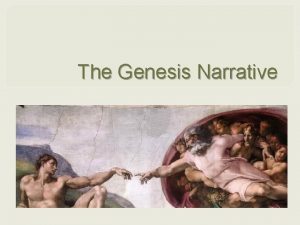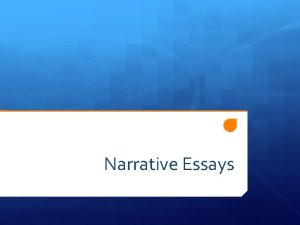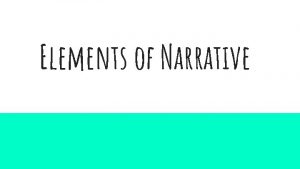Can GPS Wayfinding Technology with Narrative Descriptions Assist





























- Slides: 29

Can GPS Wayfinding Technology with Narrative Descriptions Assist in Destination Management? By Trudy Bowden-Callahan & Robert Sweetman

A Pilot Project Funded Through Ethel Louise Armstrong Foundation Grant Completed at California State University Northridge TSENG College 2011

Overview of the Project ØThe challenges for those people who are blind or visually impaired in locating their destinations ØAddressing these challenges ØWhat is GPS ? & how GPS works. ØOur purpose: to apply GPS technology in addressing navigation issues. ØNarrative descriptions & the Point of Interest (POI) description Process

ØProject collaboration & benefits of location literacy ØResearch Process & Procedure ØO & M Considerations ØFindings ~ what we learned Ø Supporting regulatory guidelines ØFuture considerations

The Challenges It is often difficult for students with visual impairments to locate important points of interest since they cannot detect landmarks, see street signs, or read the signs on buildings at a distance. .

Addressing these Challenges Improve the ability of persons who are blind or visually impaired to navigate the college campus through implementation of GPS with narrative descriptions.

What is GPS? ØGPS is classified as an electronic orientation aid (EOA ØA GPS system allows a person to determine his or her position on the surface of the earth so they can pinpoint their location within several meters.

How GPS Works Ø The GPS system is comprised of a receiver that tracks satellites that are stationed in geosynchronous orbit. Ø A GPS device must track a minimum of four satellites; thus, GPS is effective only outdoors. Ø Objects and weather can interfere with its accuracy.

Purpose Apply GPS Technology to assist persons who are blind or visually Impaired in finding their way around campus and knowing what is around.

Our idea was that narrative descriptions of locations would assist blind students in learning the campus and knowing their environment.

The ability of people to navigate independently depends on their O & M skills and the tools that they have to work with. It has a direct influence on their social interaction and their quality of life.

Our exploratory research examined GPS technology combined with narrative descriptions to both describe points of interest and orient students to the campus.

Shown here is a point of interest being marked at the Deaf & Hard of Hearing Center. We recorded 107 points, and described them in both text and audio formats.

Point of Interest (POI) Description Process Narrated and text-based descriptions were used for outdoor destination management and development of accessible destination experiences.

Points of Interest Recording Process ØA compass was used to ensure that directional information would be correct. ØThe points were then scripted and recorded in a controlled environment for consistency of sound quality. ØThe descriptions were geocoded so that they will trigger when a point of interest is reached.

Collaboration Ø We brought in an Orientation and Mobility Specialist to provide hands-on consultation to aid in development of orientation-based descriptions. Ø We also had discussions with visually impaired GPS users during the project design and implementation process. Ø This was important so that descriptive information would be relevant and useful to the end user.

Research Process All points of interest marked, and descriptive Prep. & data completed Org. of Information and 2 campus routes were developed Observation Survey potential of task & participants & interviews choose participants Completio n of Research & Research Paper

Research Procedure ØWe selected 5 individuals with a diverse social, ethnic and cultural background. ØA survey process was used to select people with some knowledge of the equipment we were using. ØWe worked with each participant for four hours. ØFirst we used a computer map simulation for a general overview of the campus. ØWe showed them how to use the GPS on the Braille. Note Apex. ØWe observed them as they followed 2 pre-set routes on campus and played audio descriptions of POIs as they came to them.

Use of Environmental Cues is important. Environmental cues are used to locate the final destination.

Orientation and Mobility Considerations Ø Include safety tips in narrative descriptions for issues encounter such as in the crossing shown here. Ø It is Important to bring in an O&M specialist to advise. Ø Factors such as reliable equipment and use of mobility aids such as a dog guide or long cane are imperative to success in independent navigation and locating of points of interest.

Benefits of Location Literacy Increased efficiency locating points of interest by using GPS descriptive information. Reduced stress and anxiety when traveling on campus because students know where they are, what is around and the location and description of their destination. Increased location literacy when traveling or working on campus for persons who rely on GPS and descriptive point of interest data. Increased satisfaction from knowing more about the campus after the wayfinding exercise All participants felt they gained helpful information from the audio descriptions

Results Ø This exploratory research demonstrated positive feedback indicating that addition of descriptive data improved orientation to the campus. Ø The results of this project can serve as a pilot study for future research.

Supporting Regulatory Guidelines Title II of the ADA requires that State and local governmental entities operate their services, programs, and activities so that, when viewed in their entirety, they're readily Rehabilitation Act of 1973 accessible to and usable Section 504 which applies by individuals with to post secondary disabilities. (28 Code of education programs or Federal Regulations (CFR) activities, that receive § 35) Federal financial assistance and to recipients that operate, or that receive Federal financial assistance for the House Bill, HR 5433, operation of such Technology Bill of Rights for programs or activities. the Blind Act of 2010, (Open (Non-discrimination) Congress 2010), aims to make mainstream technology accessible for those with vision problems.

Retention issues with GPS ØReliable equipment is important. ØMobility aids (dog guide or long cane) = success in independent navigation in locating points of interest. ØPast technologies were often abandoned because they were not designed with perceptual & functional considerations in mind. ØUser input into the process helps to increase the demand for better products and services, and reduces user abandonment.

Future Research Future research may involve a more comprehensive study working with Students who are unfamiliar with the campus and/or GPS wayfinding methods. Exploring the possibilities of data sharing among a variety of platforms such as Smart phone technology Radio Frequency Identification (RFID) tags.

The National Federation of the Blind (NFB) 2011 study found ~ Only 6% of high school graduates who are blind graduate from college, as compared to 26% for sighted individuals.

Benefits Implementing a GPS based way-finding system for the blind can address regulatory requirements & improve the college experience for students who are blind or visually impaired, perhaps having a positive impact on graduation rates!

GPS technology, combined with narrative descriptions, can enhance way finding when you cannot see the signs.

Thank you for coming! & at this point we can answer your questions!
 Pre gps wayfinding aid
Pre gps wayfinding aid Gps gps gps
Gps gps gps Gps gps gps
Gps gps gps Ghost graphic story graphic and wayfinding
Ghost graphic story graphic and wayfinding Narrative report with contextual descriptions
Narrative report with contextual descriptions Task 1 match the words with their definitions
Task 1 match the words with their definitions Cr assist
Cr assist Mcdp-1 defines trust as a product of
Mcdp-1 defines trust as a product of Quality assist
Quality assist Second heart assist
Second heart assist Cisco smart assist
Cisco smart assist Peer assist adalah
Peer assist adalah Als assist
Als assist The whips assist the party leaders by
The whips assist the party leaders by Aig travel assist
Aig travel assist Pam assist counselling
Pam assist counselling Mechanical brake assist
Mechanical brake assist Intelligent assist device
Intelligent assist device One teach, one assist pros and cons
One teach, one assist pros and cons The first step in diagnosing a hydro-boost problem is
The first step in diagnosing a hydro-boost problem is Assist user guide
Assist user guide Plan rubi colmedica
Plan rubi colmedica Pbx call assist 2
Pbx call assist 2 School mental health assist
School mental health assist Medi assist escalation matrix
Medi assist escalation matrix Fireteam wedge
Fireteam wedge Business essentials smbs springchambers9to5mac
Business essentials smbs springchambers9to5mac Kristiina jokinen
Kristiina jokinen Gx assist side effects
Gx assist side effects Active park assist 2
Active park assist 2
